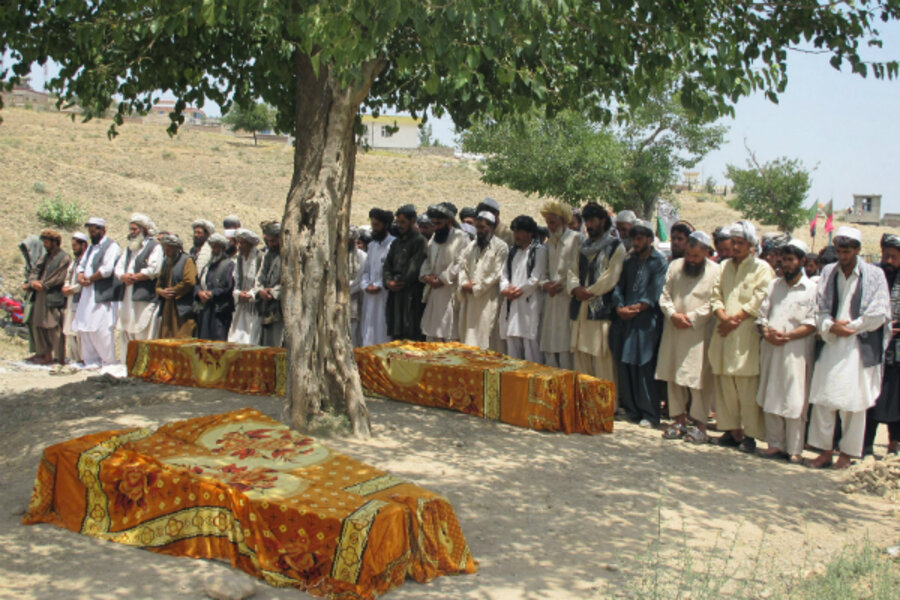Taliban attacks on US bases in Afghanistan: enabled by Pakistani forces?
Loading...
| Washington
A recent spate of attacks on US military bases in Afghanistan points to a resilient Taliban with a steady supply of arms. It is a supply stream flowing from Pakistan – one that US troops, try as they might, are proving unable to interrupt.
Equally troubling for the Pentagon, analysts warn that these attacks serve as growing evidence that Pakistani security services (ISI) is stepping up its support of insurgent groups to jockey for position ahead of the scheduled 2014 departure of US combat troops from the country.
On Wednesday, two attacks in eastern Afghanistan killed three US troops and at least 25 Afghans, prompting the US Embassy to condemn the Taliban’s “murderous campaign.”
These attacks come on the heels of one of the most troubling insurgent offensives in some time, according to analysts. It occurred earlier this month, when a suicide-bomber in a car filled with explosives was able to breach perimeter security at a large US base near the eastern Afghanistan city of Khost.
The bomber detonated the explosives near the base dining hall at Camp Salerno, allowing other enemy fighters to stream into the base on foot – and open fire. A spokesman for the Taliban boasted that the insurgents had “suicide vests, rocket-propelled grenades, heavy machine guns, and hand grenades.” The attack injured dozens of troops.
The US military did not disclose the breadth of the breach in base security for some time. When the details emerged, it was clear that, “It was a pretty significant attack in terms of the amount of explosives used – and the ability to get that close and detonate them,” says Jeffrey Dressler, a senior analyst at the Institute for the Study of War in Washington.
The sheer volume of explosives involved in the attack points to ISI links with an insurgency “that’s proving to be a continuous challenge” for US forces in eastern Afghanistan, Mr. Dressler says.
In eastern Afghan provinces such as Khost, Taliban-affiliated insurgent groups, such as the Haqqani network, maintain safe haven and logistical lines that run all the way to Pakistan – and use these places to project their power into neighboring provinces even closer to Kabul.
“The fact that these guys can move trucks full of explosives across the border” is troubling, Dressler adds. “By not taking action, Pakistani forces “are signaling their tacit approval of this stuff.”
These sorts of behaviors – including “increased collusion” between the ISI and Pakistani-based insurgent groups – “are likely to increase” with the drawdown of US forces, Dressler warns, “unless you can get into these places [in eastern Afghanistan] and go on the offensive like we did in Helmand and Kandahar [provinces of southern Afghanistan]."
Yet US troop levels required for such operations are unlikely to materialize, as the drawdown of forces in Afghanistan continues apace. What’s more, US commanders have pointed out that offensive operations in the harsh mountainous regions of the east have been little more than “lawn-mowing” operations and that once US forces leave after fighting tough, casualty-heavy battles, the insurgency returns.
Because Afghan forces have been unable and in some cases unwilling to battle Pakistan-based insurgents, these operations have had little effect connecting the Afghan central government to remote outlying regions – a key component of counterinsurgency warfare.
In the midst of this uncertainty, Pakistan’s security forces continue to jockey for position, using insurgent groups in order to “control as much of the south and the east as it can,” Dressler adds. “All of the stuff we’re seeing now tracks with that ultimate objective.”
Without stepped-up US forces in the east, “I guess I’m just wondering where the red lines are,” he says. “How much are we willing to put up with when it comes to these sorts of attacks?"







